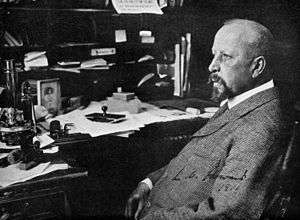Leland Ossian Howard
Leland Ossian Howard, Ph.D., M.D. (June 11, 1857 in Rockford, Illinois – May 1, 1950), was a pioneer American entomologist who worked in the US Department of Agriculture. Serving as the chief of the bureau of entomology, a successor to C.V. Riley, he helped establish economic entomology as a profession in the United States and strengthened research activities, helping establish laws to prevent the introduction of agricultural pests. He was a specialist on the Hymenopteran family Chalcididae, which are parasitic and contributed to the introduction of biological control agents for pest management. Howard also took an interest in medical entomology.

Early life
Howard was born to Ossian Gregory Howard, a lawyer, and Lucy Denham Thurber on 11 June 1857. His relatives from his mother's side included the Harvard astronomer E.C. Pickering while other distant relatives included Senator J.M. Howard and President William Howard Taft. Shortly after his birth, the family moved from Rockford, to Ithaca, New York where his father worked with a law firm. Howard attended Ithaca Academy. An interest in insect collecting encouraged by his parents with the gift of The Butterfly Hunters by Mary Treat at the age of 10 followed by more books and at the age of 13, along with another collector friend, recorded the introduction of the European cabbage butterfly (Pieris rapae) in the Catskill region. Along with his friends, he founded the Ithaca Natural History Society to meet and discuss papers and insects. While out collecting one day, he met John Henry Comstock, who invited him to his lab at Cornell University. Howard enrolled in Cornell in September 1873, three years after the death of his father, and following the advice of his mother's friends, went to study civil engineering. Doing poorly in differential calculus made him drop engineering and he began to study other subjects including French, German, and Italian. He then joined Comstock's lab as the first research student and graduated in June 1877 with a thesis on respiration in the larva of Corydalis cornutus. He worked with Burt Green Wilder and Simon Henry Gage and received a masters at Cornell. In the 1880s, he also attended Columbian College (now George Washington University) for medicine, although he didn't complete it. He however received an honorary MD from the same university in 1911 for his contribution to medical entomology.[1]
Career
In July 1878, on the recommendation of Professor Comstock, he applied for a post in the U.S. Department of Agriculture as an assistant entomologist to C.V. Riley. The salary was low ($100/month) and despite advice against joining it from many friends and family, he took up the job. Among his first tasks was to prepare a manual on sericulture which was published with Riley as the author. Riley was replaced by Professor Comstock and again many of his writings went under the authorship of Comstock. This was accepted practice and Howard changed this practice when he rose in authority and ensured that all his co-workers were appropriately credited, and he eventually became chief of the Bureau of Entomology in 1894. He held the position until 1 October 1927. He continued to consult the Bureau until officially retiring on 30 June 1931. He worked on the systematics of the parasitic Hymenoptera, biological control, and medical entomology of mosquitoes and flies.[1]
He was the editor of Insect Life, lecturer on entomology at several colleges and universities, and a contributor to reference books on the subject of entomology. He was made permanent secretary of the American Association for the Advancement of Science, honorary curator in the United States National Museum, and consulting entomologist of the Public Health Service. He was elected to the National Academy of Sciences in 1916 and since 1907 was a Fellow of the Entomological Society of America.[2]
Personal life
Howard married Marie T. Clifton in 1886, "a girl with a glorious soprano voice", who he met while singing in a choir at college. They had three daughters. Howard was known for his interests in sports.[1]
Publications
- Mosquitoes, McClure, Phillips & co., 1901
- The Insect Book, Doubleday, Page & Company, 1901
- The House Fly-Disease Carrier, Frederick A. Stokes company, 1911
- Mosquitoes of North and Central America and the West Indies, Authors Leland Ossian Howard, Harrison Gray Dyar Jr., Frederick Knab, Carnegie Institution of Washington, 1917
- The Insect Menace, Century, 1931
- Fighting the insects: the story of an entomologist, MacMillan, 1933 (autobiography)
Notes
- Russell, L M (1978). "Leland Ossian Howard: A Historical Review". Annual Review of Entomology. 23 (1): 1–17. doi:10.1146/annurev.en.23.010178.000245. ISSN 0066-4170.
- "List of ESA Fellows". Entomological Society of America. Retrieved September 8, 2019.
References
- Bishopp, Fred Corry (1957). "Leland Ossian Howard Centennial 1857–1957". Bulletin of the Entomological Society of America. 3 (3): 1–3. doi:10.1093/besa/3.3.1.CS1 maint: ref=harv (link)
- Essig, E. O. (1931). A History of Entomology. MacMillan Company. pp. 658-664.CS1 maint: ref=harv (link)
- Graf, John E.; Graf, Dorothy W. (1959). "Leland Ossian Howard 1857-1950" (PDF). Biographical Memoirs. National Academy of Sciences.CS1 maint: ref=harv (link)
- Howard, Leland Ossian (1933). Fighting the Insects: The Story of an Entomologist, Telling of the Life and Experiences of the Writer. Macmillan Company.CS1 maint: ref=harv (link)
- Mallis, Arnold (1971). American Entomologists. Rutgers University Press. pp. 79–86. ISBN 0-8135-0686-7.CS1 maint: ref=harv (link)
- Russell, Louise M. (1978). "Leland Ossian Howard: A Historical Review". Annual Review of Entomology. 23: 1–15. doi:10.1146/annurev.en.23.010178.000245.CS1 maint: ref=harv (link)
- Sterling, Keir B., ed. (1997). "Howard, Leland Ossian". Biographical Dictionary of American and Canadian Naturalists and Environmentalists. Greenwood Press.CS1 maint: ref=harv (link)
External links
| Wikimedia Commons has media related to Leland Ossian Howard. |
| Wikisource has original works written by or about: Leland Ossian Howard |
- National Academy of Sciences Biographical Memoir
- Works by Leland Ossian Howard at Project Gutenberg
- Works by or about Leland Ossian Howard at Internet Archive